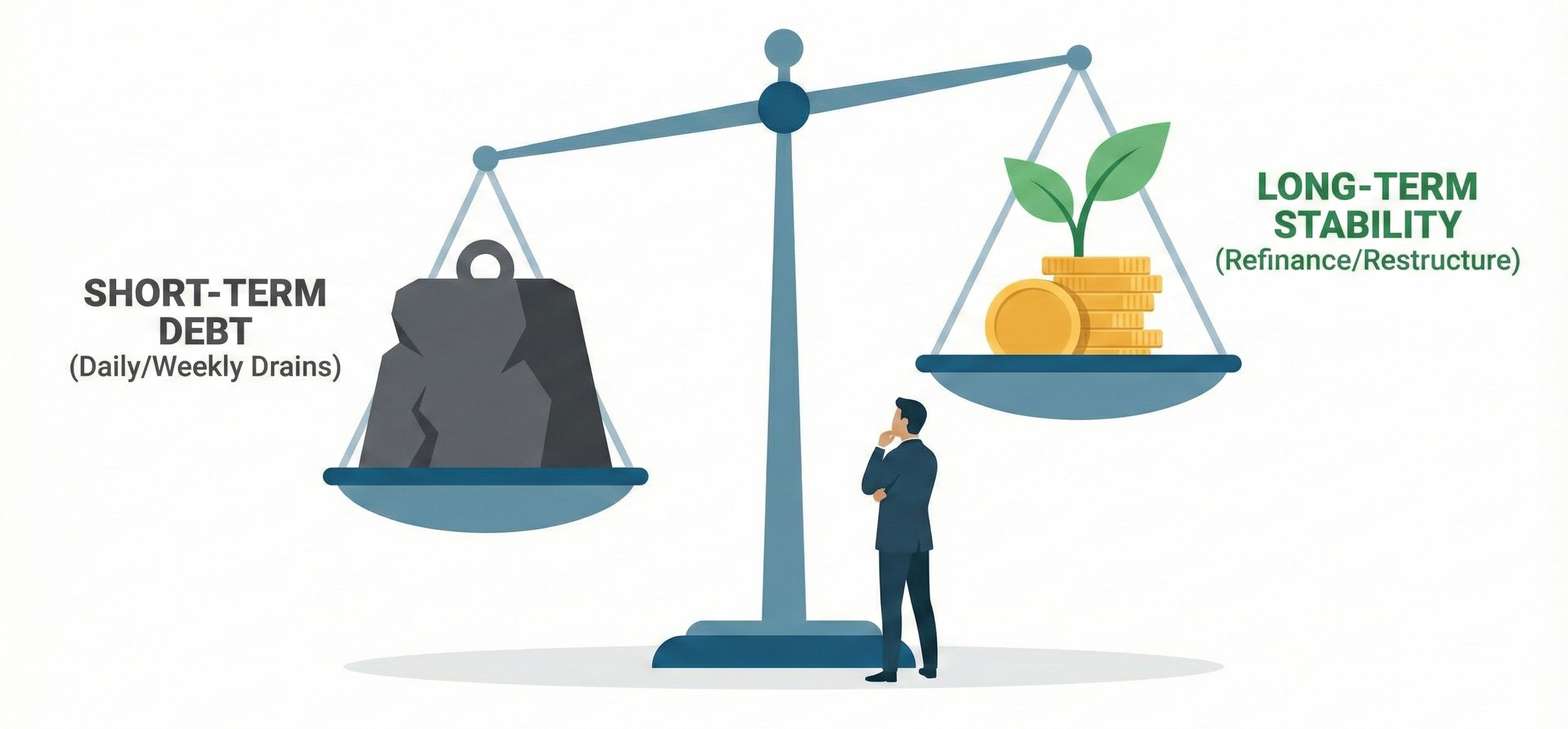It's at this vulnerable moment that the siren song of short-term loans from certain types of creditors becomes almost irresistible.
They promise quick access to funds, often with seemingly minimal paperwork and rapid approval times. In your desperation, it's easy to see these offers as a lifeline, a way to bridge the gap and get your business back on solid footing.
However, for many business owners, these short-term loans can turn into a dangerous trap, sucking the cash flow and lifeblood out of their already struggling enterprises.
This article will delve into the perils of these "bloodsucking creditors" and their short-term loan offerings, providing you with the knowledge and strategies to navigate cash flow challenges without falling victim to predatory lending practices. We will explore the common tactics these lenders employ, the true cost of their loans, and, most importantly, viable alternative solutions to help your business thrive in the long run.
Understanding the Cash Flow Crunch and Why It Happens
Before we delve into the dangers of predatory short-term business loans, it's crucial to understand why business cash flow crises occur in the first place.
Cash flow, simply put, is the movement of money into and out of your business. Positive cash flow means more money is coming in than going out, while negative cash flow indicates the opposite. Several factors can contribute to a cash flow crunch:
● Delayed Payments: This is a common pain point for many small businesses. Clients taking extended payment terms, or simply being slow to pay, can create a significant gap between when you incur expenses and when you receive revenue.
● Unexpected Expenses: Equipment breakdowns, emergency repairs, legal fees, or sudden increases in operating costs can all drain your cash reserves unexpectedly.
● Inventory Issues: Holding too much inventory ties up valuable capital, while not having enough can lead to lost sales and dissatisfied customers. Striking the right balance is crucial.
● Seasonal Fluctuations: Businesses with seasonal demand may experience periods of high revenue followed by leaner times, making cash flow management challenging.
● Poor Financial Planning: Lack of accurate forecasting, inadequate budgeting, and insufficient tracking of income and expenses can leave you unprepared for potential cash shortfalls.
● Rapid Growth: While seemingly a positive problem, rapid expansion can strain cash flow as you invest in more resources, hire more staff, and potentially extend more credit to new customers before revenue catches up.
● Economic Downturns: External economic factors can impact customer spending and overall demand, leading to reduced sales and cash flow challenges.
Understanding the root causes of your cash flow problems is the first step towards finding sustainable solutions. Masking the issue with a high-cost, short-term loan will only exacerbate the underlying problems in the long run.
Identifying the "Bloodsucking Creditors": Red Flags to Watch For
Not all lenders are created equal. While legitimate financial institutions offer valuable services, certain creditors prey on vulnerable small business owners facing cash flow emergencies. These "bloodsucking creditors" often employ specific tactics and offer loan terms that can quickly spiral into unmanageable debt. Here are some red flags to watch for:
● Extremely High Interest Rates: This is the most obvious indicator. Be wary of annual percentage rates (APRs) that are significantly higher than those offered by traditional banks or credit unions. Some predatory lenders charge triple-digit or even higher APRs.
● Short Repayment Terms: Loans with very short repayment periods, often just a few weeks or months, can put immense pressure on your cash flow. These terms may seem manageable initially, but the frequent and large payments can quickly become overwhelming.
● Daily or Weekly Repayments: While seemingly convenient, daily or weekly repayment schedules can disrupt your cash flow and make it difficult to manage other expenses. This frequency also often masks the high cost of the loan.
● Excessive Fees: Look out for a multitude of fees, such as origination fees, underwriting fees, processing fees, and even late payment fees that are disproportionately high. These fees can significantly increase the overall cost of the loan.
● Aggressive Sales Tactics: High-pressure sales pitches, promises of instant approval, and a lack of transparency about the loan terms are all red flags. Legitimate lenders will take the time to understand your business needs and clearly explain the terms and conditions of the loan.
● Limited Paperwork and Due Diligence: While quick approval might seem appealing, lenders who don't thoroughly assess your business's financial health are likely more interested in profiting from high interest rates and fees than in your long-term success.
● Focus on Repayment Amount, Not APR: Predatory lenders often focus on the seemingly small daily or weekly repayment amount, downplaying the significantly higher overall cost reflected in the APR. Always ask for and understand the full APR.
● Pre-computation of Interest and Fees: Loans where interest and fees are calculated upfront and added to the principal can make it difficult to pay off the loan early and reduce your overall cost.
● Blank or Incomplete Loan Agreements: Never sign a loan agreement that is blank or contains incomplete information. Ensure all terms, interest rates, fees, and repayment schedules are clearly documented.
By being aware of these red flags, you can better identify and avoid predatory lenders who seek to exploit your financial vulnerability.
The Illusion of Speed and Simplicity: How They Hook You
One of the primary reasons small business owners turn to these "bloodsucking creditors" is the promise of speed and simplicity. When facing an immediate cash flow crisis, the thought of navigating lengthy bank loan applications and waiting weeks for approval can seem daunting. Predatory lenders capitalize on this urgency by offering:
● Fast Approval Times: They often boast about same-day or next-day funding, which can be incredibly appealing when you have urgent bills to pay.
● Minimal Paperwork: The application process is often streamlined, requiring less documentation than traditional loans. This can seem like a relief when you're already stressed and time-constrained.
● Relaxed Credit Requirements: Unlike banks that typically require strong credit scores and established business history, some short-term lenders are more lenient, making their loans accessible to businesses that may not qualify for traditional financing.
However, this speed and simplicity come at a steep price. The lack of thorough underwriting means the lender is taking on more risk, which they compensate for by charging exorbitant interest rates and fees. The minimal paperwork often masks complex and unfavorable loan terms that borrowers may not fully understand until it's too late. The relaxed credit requirements simply mean the lender is willing to profit from borrowers who are more likely to struggle with repayment, perpetuating a cycle of debt.
Don't let the allure of quick cash blind you to the long-term consequences. Take the time to carefully evaluate all your options and understand the true cost of any loan before you sign on the dotted line.
The True Cost of Short-Term Loans: A Debt Trap
While the initial loan amount might seem manageable, the true cost of short-term loans from predatory lenders can be devastating for small businesses. The combination of high interest rates, short repayment terms, and hefty fees can quickly create a debt trap that is difficult to escape.
Let's illustrate with a simplified example:
Imagine your business needs $10,000 to cover an unexpected expense. A traditional bank loan might offer an interest rate of 8% per year with a repayment term of three years. A predatory short-term lender might offer the same $10,000 with an APR of 50% and a repayment term of just six months, along with a $500 origination fee.
● Traditional Bank Loan: Over three years, you would pay approximately $1,275 in interest, resulting in a total repayment of $11,275. Your monthly payment would be around $313.
● Predatory Short-Term Loan: Over six months, you would pay significantly more in interest due to the high APR. Factoring in the $500 origination fee, the total cost of the loan could easily exceed $15,000 or more. Your much larger monthly (or even weekly) payments would put a severe strain on your cash flow.
Furthermore, if you struggle to make even one payment on the short-term loan, you could face substantial late payment fees and potentially be forced to take out another high-cost loan to cover the shortfall, digging yourself deeper into debt. This cycle of borrowing can quickly become unsustainable, ultimately leading to business failure.
It's crucial to look beyond the initial loan amount and focus on the total cost of borrowing, including all interest and fees, and the impact the repayment schedule will have on your business's cash flow.
Alternative Solutions: Navigating Cash Flow Challenges Wisely
Fortunately, there are several alternative solutions that small business owners can explore to address cash flow challenges without resorting to predatory short-term loans. These options may require more effort upfront but offer more sustainable and affordable solutions in the long run:
● Negotiate Payment Terms with Customers: Proactively communicate with your clients and try to negotiate shorter payment terms. Offering small discounts for early payments might incentivize them to pay faster.
● Manage Inventory Effectively: Optimize your inventory levels to avoid tying up excessive capital. Implement inventory management systems and consider just-in-time inventory strategies where appropriate.
● Cut Unnecessary Expenses: Review your operating costs and identify any non-essential expenses that can be reduced or eliminated. Even small savings can add up over time.
● Invoice Factoring: This involves selling your outstanding invoices to a factoring company at a discount in exchange for immediate cash. This can provide a quick influx of funds without incurring debt.
● Lines of Credit: A business line of credit offers flexibility, allowing you to draw funds as needed up to a certain limit and only pay interest on the amount you borrow. This can be a good option for managing short-term cash flow fluctuations.
● Small Business Loans from Traditional Banks and Credit Unions: While the application process may be more rigorous, traditional lenders typically offer more favorable interest rates and repayment terms. Explore options like term loans or SBA loans.
● Peer-to-Peer Lending Platforms: Online platforms connect borrowers with individual investors, potentially offering more competitive rates than some traditional lenders.
● Grants and Government Assistance Programs: Research available grants and government programs designed to support small businesses. These can provide non-repayable funding for specific purposes.
● Build a Cash Reserve: When your business is doing well, make it a priority to build a cash reserve that can be used to weather unexpected financial storms.
● Improve Your Financial Planning: Develop accurate financial forecasts, create a detailed budget, and regularly monitor your cash flow to anticipate potential shortfalls and take proactive steps.
By exploring these alternatives, you can find solutions that address your cash flow needs without jeopardizing the long-term financial health of your business.
Seeking Professional Help: When to Ask for Guidance
If you are struggling with a cash flow crisis or are unsure about the best course of action, don't hesitate to seek professional help. Several resources are available to provide guidance and support:
● Accountants and Financial Advisors: These professionals can help you analyze your financial situation, develop strategies for managing cash flow, and explore financing options.
● Small Business Development Centers (SBDCs): SBDCs offer free or low-cost counseling and training to small business owners, including assistance with financial planning and loan applications.
● SCORE Mentors: SCORE is a non-profit organization that provides free business mentoring services from experienced professionals.
● Non-profit Credit Counseling Agencies: These agencies can provide debt counseling and help you develop a debt management plan.
Seeking professional advice can provide you with objective insights and help you make informed decisions to navigate your cash flow challenges effectively.
Protecting Your Business: Prevention is Key
While having strategies to address cash flow crises is important, the best approach is to prevent them from happening in the first place. Here are some proactive steps you can take to protect your business:
● Maintain Strong Customer Relationships: Build strong relationships with your clients and ensure they are satisfied with your products or services. This can lead to repeat business and more reliable payments.
● Diversify Your Customer Base: Avoid relying too heavily on a single customer, as their financial difficulties could significantly impact your cash flow.
● Implement Robust Invoicing and Collection Procedures: Send invoices promptly, clearly outline payment terms, and follow up on overdue payments in a timely and professional manner.
● Monitor Your Key Performance Indicators (KPIs): Regularly track metrics such as accounts receivable turnover, accounts payable turnover, and cash conversion cycle to identify potential cash flow issues early on.
● Stay on Top of Your Expenses: Regularly review your expenses and look for opportunities to reduce costs without compromising the quality of your products or services.
● Develop Contingency Plans: Prepare for potential unexpected events by having a plan in place to address cash flow shortfalls. This might include having a small emergency fund or pre-approved line of credit.
● Educate Yourself About Financial Management: Continuously learn about best practices in financial planning, budgeting, and cash flow management.
By taking these proactive steps, you can build a more resilient business that is better equipped to weather financial challenges and maintain healthy cash flow.
Choose Sustainability Over Short-Term Relief
When faced with a cash flow crisis, the allure of quick cash from "bloodsucking creditors" can be strong. However, it's crucial to remember that these short-term loans often come with devastating long-term consequences. The high interest rates, short repayment terms, and excessive fees can quickly trap your business in a cycle of debt, ultimately jeopardizing its survival.
Instead of succumbing to the siren song of predatory lending, take the time to understand the root causes of your cash flow challenges and explore viable alternative solutions. Negotiate with customers, manage your inventory effectively, cut unnecessary expenses, and consider options like invoice factoring or lines of credit. Seek professional help if needed and prioritize building a strong financial foundation for your business through proactive planning and management.
Choose sustainability over short-term relief. By making informed decisions and avoiding the traps of predatory lending, you can navigate cash flow crises effectively and build a thriving, resilient small business for the long haul.
What is the Best Way to Deal with Business Debt Payments that are causing Business Cash Flow issues?
It is NOT by stopping ACH payments.
It is NOT by taking on another business loan.
It is NOT ALWAYS a Refinancing
It is NOT by entering into a debt settlement program.
Find out the BEST strategies to get your Business back to where it was






























